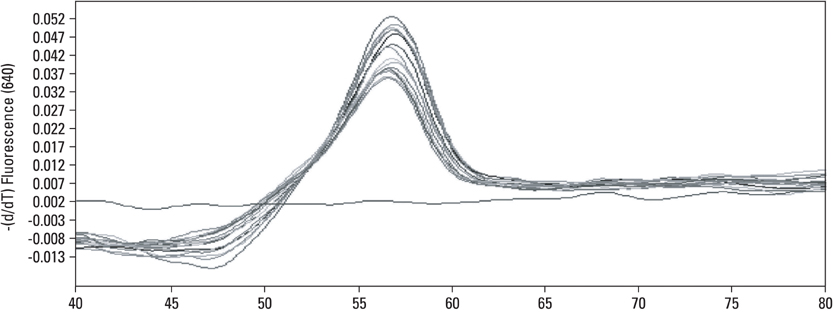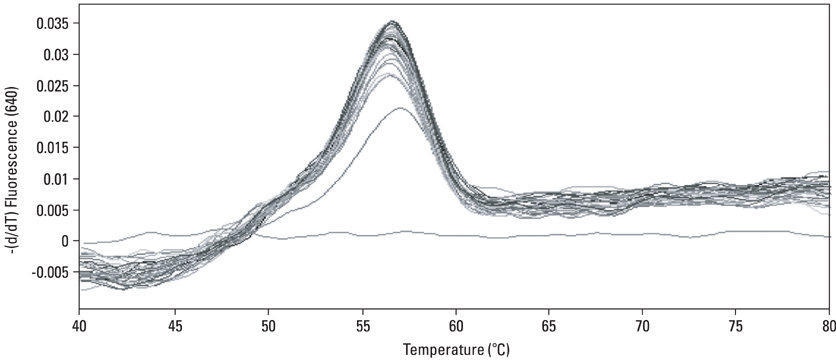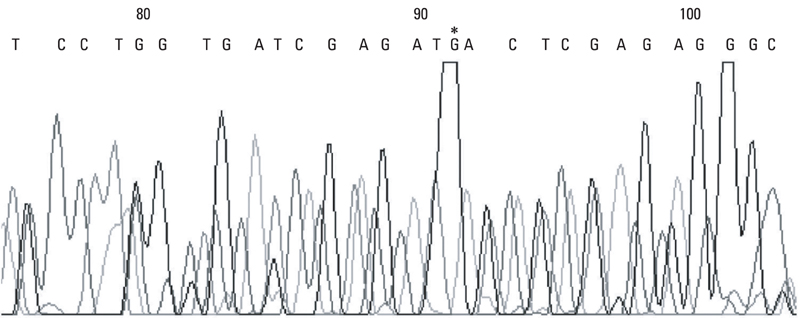Yonsei Med J.
2009 Aug;50(4):564-568. 10.3349/ymj.2009.50.4.564.
Polymorphism of a COLIA1 Gene Sp1 Binding Site in Korean Women with Pelvic Organ Prolapse
- Affiliations
-
- 1Department of Obstetrics and Gynecology, Yonsei University College of Medicine, Seoul, Korea. swbai@yuhs.ac
- 2Department of Laboratory Medicine, Yonsei University College of Medicine, Seoul, Korea.
- 3Department of Pathology, Yonsei University College of Medicine, Seoul, Korea.
- KMID: 1758618
- DOI: http://doi.org/10.3349/ymj.2009.50.4.564
Abstract
- PURPOSE
To evaluate the possible influence of G-->T substitution at the Sp1-binding site of the COLIA1 gene on the risk of pelvic organ prolapse (POP). MATERIALS AND METHODS: The study group consisted of 15 women with advanced stage POP. Fifteen control subjects with uterine myomas among the postmenopausal women were matched for age and parity. DNA was obtained from peripheral blood leukocytes. The fragments of the first intron of the COLIA1 gene were amplified by real time polymerase chain reaction. The polymorphism was identified using LightCycler Technology with hybridization probes. Sequencing reactions were performed on each template using commercial primer. RESULTS: Two groups had no significant difference in medical history, surgical, and smoking history. The homozygous peaks in two groups were noted at 57degrees C on melting curve analysis. Sequencing reactions confirmed the G/G alleles in the 30 specimens tested. We could not find any polymorphism at the Sp1-binding site in COLIA1 gene with advanced stage POP. Statistical significance was considered to be p < .05. CONCLUSION: The polymorphism of the Sp1-binding site in the COLIA1 gene did not contribute to the development of POP in Korea.
Keyword
MeSH Terms
Figure
Reference
-
1. Nikolova G, Lee H, Berkovitz S, Nelson S, Sinsheimer J, Vilain E, et al. Sequence variant in the laminin gamma1 (LAMC1) gene associated with familial pelvic organ prolapse. Hum Genet. 2007. 120:847–856.2. Seo JT, Kim JM. Pelvic organ support and prevalence by Pelvic Organ Prolapse-Quantification (POP-Q) in Korean women. J Urol. 2006. 175:1769–1772.
Article3. Dietz HP. Do Asian women have less pelvic organ mobility than Caucasians? Int Urogynecol J Pelvic Floor Dysfunct. 2003. 14:250–253.
Article4. Swift S, Woodman P, O'Boyle A, Kahn M, Valley M, Bland D, et al. Pelvic Organ Support Study (POSST): the distribution, clinical definition, and epidemiologic condition of pelvic organ support defects. Am J Obstet Gynecol. 2005. 192:795–806.
Article5. Geldenhuys FG. [Genital prolapse in the Bantu]. S Afr Med J. 1950. 24:749–751.6. Rortveit G, Brown JS, Thom DH, Van Den Eeden SK, Creasman JM, Subak LL. Symptomatic pelvic organ prolapse: prevalence and risk factors in a population-based, racially diverse cohort. Obstet Gynecol. 2007. 109:1396–1403.7. Weber AM, Buchsbaum GM, Chen B, Clark AL, Damaser MS, Daneshgari F, et al. Basic science and translational research in female pelvic floor disorders: proceedings of an NIH-sponsored meeting. Neurourol Urodyn. 2004. 23:288–301.
Article8. Martin GR, Timpl R. Laminin and other basement membrane components. Annu Rev Cell Biol. 1987. 3:57–85.
Article9. Jeon MJ, Bai SW. Use of grafts in pelvic reconstructive surgery. Yonsei Med J. 2007. 48:147–156.
Article10. Goepel C, Hefler L, Methfessel HD, Koelbl H. Periurethral connective tissue status of postmenopausal women with genital prolapse with and without stress incontinence. Acta Obstet Gynecol Scand. 2003. 82:659–664.
Article11. Jackson SR, Avery NC, Tarlton JF, Eckford SD, Abrams P, Bailey AJ. Changes in metabolism of collagen in genitourinary prolapse. Lancet. 1996. 347:1658–1661.
Article12. Falconer C, Blomgren B, Johansson O, Ulmsten U, Malmström A, Westergren-Thorsson G, et al. Different organization of collagen fibrils in stress-incontinent women of fertile age. Acta Obstet Gynecol Scand. 1998. 77:87–94.
Article13. Chiaffarino F, Chatenoud L, Dindelli M, Meschia M, Buonaguidi A, Amicarelli F, et al. Reproductive factors, family history, occupation and risk of urogenital prolapse. Eur J Obstet Gynecol Reprod Biol. 1999. 82:63–67.
Article14. Grant SF, Reid DM, Blake G, Herd R, Fogelman I, Ralston SH. Reduced bone density and osteoporosis associated with a polymorphic Sp1 binding site in the collagen type I alpha 1 gene. Nat Genet. 1996. 14:203–205.
Article15. Mann V, Ralston SH. Meta-analysis of COL1A1 Sp1 polymorphism in relation to bone mineral density and osteoporotic fracture. Bone. 2003. 32:711–717.
Article16. Skorupski P, Król J, Starega J, Adamiak A, Jankiewicz K, Rechberger T. An alpha-1 chain of type I collagen Sp1-binding site polymorphism in women suffering from stress urinary incontinence. Am J Obstet Gynecol. 2006. 194:346–350.17. Skorupski P, Miotła P, Jankiewicz K, Rechberger T. Polymorphism of the gene encoding alpha-1 chain of collagen type I and a risk of pelvic organ prolapse--a preliminary study. Ginekol Pol. 2007. 78:852–855.18. Rodrigues AM, Giräo MJ, da Silva ID, Sartori MG, Martins Kde F, Castro Rde A. COL1A1 Sp1-binding site polymorphism as a risk factor for genital prolapse. Int Urogynecol J Pelvic Floor Dysfunct. 2008. 19:1471–1475.19. Bump RC, Mattiasson A, Bø K, Brubaker LP, DeLancey JO, Klarskov P, et al. The standardization of terminology of female pelvic organ prolapse and pelvic floor dysfunction. Am J Obstet Gynecol. 1996. 175:10–17.
Article20. Thom DH, van den Eeden SK, Ragins AI, Wassel-Fyr C, Vittinghof E, Subak LL, et al. Differences in prevalence of urinary incontinence by race/ethnicity. J Urol. 2006. 175:259–264.
Article21. Cox PS, Webster D. Genital prolapse amongst the Pokot. East Afr Med J. 1975. 52:694–699.22. Peacock LM, Wiskind AK, Wall LL. Clinical features of urinary incontinence and urogenital prolapse in a black inner-city population. Am J Obstet Gynecol. 1994. 171:1464–1469.
Article23. Vinkanharja A, Melkko T, Risteli J, Risteli L. New PCR-based method for the Sp1 site polymorphism in the COLIA1 gene. Clin Chem Lab Med. 2001. 39:624–626.24. Nakajima T, Ota N, Shirai Y, Hata A, Yoshida H, Suzuki T, et al. Ethnic difference in contribution of Sp1 site variation of COLIA1 gene in genetic predisposition to osteoporosis. Calcif Tissue Int. 1999. 65:352–353.
Article25. Han KO, Moon IG, Hwang CS, Choi JT, Yoon HK, Min HK, et al. Lack of an intronic Sp1 binding-site polymorphism at the collagen type I alpha1 gene in healthy Korean women. Bone. 1999. 24:135–137.
Article




